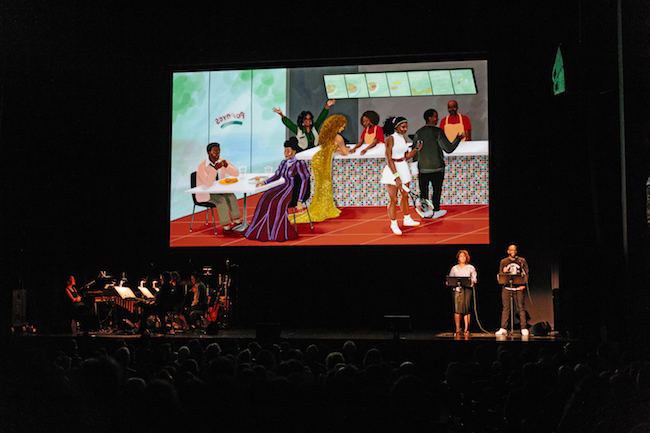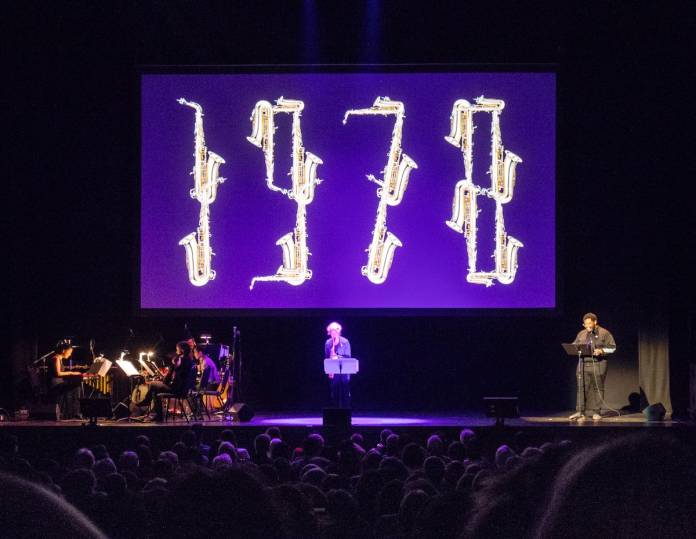“Live is definitely its own medium,” says Anita Badejo, senior producer for Pop-Up Magazine—the marvelous, one-time-only, three-times-a-year live show that originates in the Bay Area and tours around the county. (This edition launches at Oakland’s Paramount Theater, May 10). “So just as a story comes across differently online, or in the pages of a magazine, or on a podcast or film, it lives differently on our stage.”
The stories told at Pop-Up Magazine, which garnered a Best of the Bay Editor’s Pick in 2010, range from in-depth character studies and spooky mysteries to hyper-contemporary flights of fancy and enthralling personal reminiscences. All have some intriguing multimedia aspect (projected Power Points with original illustrations, sound effects, puppets), and the whole thing is accompanied by house band Magik*Magik Orchestra, playing original music.
Pop-Up Magazine comes from the folks who put out California Sunday Magazine—but don’t expect the show to be documented in the pages of that publication, or online at all. Pop-Up is an intentionally in-the-moment experience: You just have to be there. Popping up for spring? Contributions from Queen of Versailles director Lauren Greenfield, New York Times Op-Ed editor Jenée Desmond-Harris, Found Magazine editor David Rothbart, New Yorker food correspondent Helen Rosner, style photographer Andres Gonzalez, and fantastic Oakland musician Fantastic Negrito, and more.
I spoke with Badejo about the mechanics and purpose of putting on such a briefly incandescent spectacle, and the allure of live narrative in our screen-glued times.

48 HILLS You always have such eclectic lineups at Pop-Up Magazine shows. With so much creative work and reporting being generated in the world, how do you choose what stories to tell?
ANITA BADEJO We accept and receive pitches constantly, and we also reach out to folks whose work we admire to see if they’d be interested contributing. Usually the process starts with a phone call to see what people are up to, what they’ve been working on, what they’re excited about. Sometimes folks are debuting things in the show—part of a bigger project they’re working on that’s going to be released later, or a story that’s on its way to being published.
Other times people come up with things whole-cloth just for the show, generating an idea that’s specific to Pop-Up, which has a live feel from the beginning. Sometimes journalists who have focused on one issue or character for a long time, that they may have published about before, will pick up a line or a paragraph in previous story and draw that out into something that really works great as a live presentation, and is its own amazing, revealing story unto itself.
What ties all this together is that the work is new, it’s never been published before as a podcast or documentary.
Help us save local journalism!
Every tax-deductible donation helps us grow to cover the issues that mean the most to our community. Become a 48 Hills Hero and support the only daily progressive news source in the Bay Area.
48H I assume there’s a lot of dramaturgy and stage magic that goes into transforming some of these stories into “pop-up” forms of their own—the lights, the music, and really just having writers and presenters actually perform their works for a big audience, rather than just read something off of a monitor.
AB It’s funny because when we start out working with people, our thought process is ‘we’re a magazine, we’re a magazine, we’re a magazine!’ And then at some point our thought process completely turns and then it’s ‘we’re a theater production!’
We work very closely with them to help craft them in a way that makes sense for live. No one’s ever producing stuff on their own that we then just plug in, it’s pretty much a collaborative effort. We draw upon all the resources we have in addition to the script or the text, or the films or the photos. We’ve commissioned opera singers before to help tell the stories, dancers, original photography and animation, interactive elements with audience participation. We’ve glued things into peoples’ programs that the have to take out during the course of the story. And we have an original score by our house group, Magik*Magik.
We like to play and experiment with what’s the best and most effective way for people to take in the story, and really understand the information that’s being conveyed.

48H Can you share a particular highlight of this upcoming show?
AB Jenée Desmond-Harris, who’s coming on tour with us—she grew up in Mill Valley, lives in Palo Alto, and was a Knight Fellow, so she’s a Bay Area person through and through. Her story is really incredible. It takes place in San Francisco, and is about a “sex therapy institute” that existed in the 1970s, and has a ton of twists and turns in it. It should really be made into a movie at some point. I don’t want to give too much away, but I will say that the people who ran the institute are people that she is very close to.
48H Pop-Up Magazine defines itself again the Internet by emphasizing the “you have to be there” element. It’s very experiential: Nothing goes online afterwards, there’s no recording, etc. How do you feel that’s important?
AB It’s true, our show is intentionally ephemeral. You do have to be there to see it, and that’s something that’s always been a core of our philosophy and how we put together a show. I think it’s more important now than ever. We’re in an age when we’re all just inundated with information all of the time. I wake up and my phone has 20 notifications on it, and then I get online and I read 15 Facebook posts with different pieces of information, and then I go on Twitter … I think when people have so much to consume and parse though, it’s really important that we create space where we can put our technology aside, and take in stories in a way that we can just focus on who is telling a story and what they’re saying—without any distractions.
This is even more powerful in a communal atmosphere where everyone is focusing on this one particular moment in time. It can be really magical.
POP-UP MAGAZINE
May 10, 7:30pm, $38-$42
Paramount Theatre, Oakland
Tickets and more info here.





